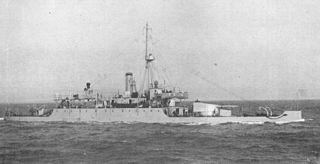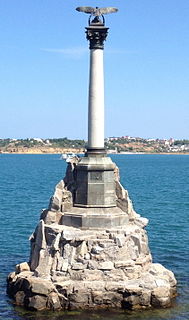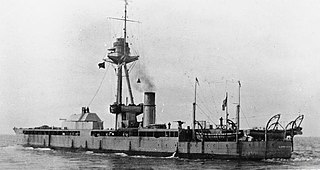
HMS Mersey was a Humber-class monitor of the Royal Navy. Originally built by Vickers for Brazil and christened Madeira, she was purchased by the Royal Navy in 1914 on the outbreak of the First World War along with her sister ships Humber and Severn.
Nine ships of the Royal Navy have been named HMS Severn after the River Severn:

Scuttling is the deliberate sinking of a ship. Scuttling may be performed to dispose of an abandoned, old, or captured vessel; to prevent the vessel from becoming a navigation hazard; as an act of self-destruction to prevent the ship from being captured by an enemy force ; as a blockship to restrict navigation through a channel or within a harbor; to provide an artificial reef for divers and marine life; or to alter the flow of rivers.

HMS Terror was an Erebus-class monitor built for the Royal Navy during the First World War in Belfast. Completed in 1916, she was assigned to the Dover Patrol where her primary duties involved bombarding German targets on the coast of occupied Belgium, particularly at the ports of Zeebrugge and Ostend. In October 1917 Terror was hit by three torpedoes, taking severe damage to the bow and had to be towed into Portsmouth for repair. In April 1918 she participated in the Zeebrugge raid and provided gunnery support for the Fifth Battle of Ypres in September of the same year.

HMS Manica was a merchant steamship that was built in England in 1901 and was scrapped in Japan in 1931. She was built as a dry cargo ship but spent the latter part of her career as an oil tanker.

The Battle of the Rufiji Delta was fought in German East Africa from October 1914–July 1915 during the First World War, between the German Navy's light cruiser SMS Königsberg, and a powerful group of British warships. The battle was a series of attempts, ultimately successful, to sink the blockaded German light cruiser.

The BL 15-inch Mark I succeeded the BL 13.5-inch Mk V naval gun. It was the first British 15-inch (381 mm) gun design and the most widely used and longest lasting of any British designs, and arguably the most successful heavy gun ever developed by the Royal Navy. It was deployed on capital ships from 1915 until 1959 and was a key Royal Navy gun in both World Wars.

Coastal defence ships were warships built for the purpose of coastal defence, mostly during the period from 1860 to 1920. They were small, often cruiser-sized warships that sacrificed speed and range for armour and armament. They were usually attractive to nations that either could not afford full-sized battleships or could be satisfied by specially designed shallow-draft vessels capable of littoral operations close to their own shores. The Nordic countries and Thailand found them particularly appropriate for their island-dotted coastal waters. Some vessels had limited blue-water capabilities; others operated in rivers.

The BL 18-inch Mk I naval gun was a breech-loading naval rifle used by the Royal Navy during World War I. It was the largest and heaviest gun ever used by the British. Only the Second-World-War Japanese 46 cm/45 Type 94 had a larger calibre, 18.1 inches (46 cm) and lighter shell. The gun was a scaled-up version of the BL 15 inch Mk I naval gun and was developed to equip the "large light cruiser" Furious. Its barrel length of 60' was just 40 calibres, slightly limiting its muzzle velocity.

HMS Lord Clive was the lead ship of her class of eight monitors built for the Royal Navy during World War I. Their primary armament was taken from obsolete pre-dreadnought battleships. The ship spent the war in the English Channel bombarding German positions along the Belgian coast as part of the Dover Patrol, often serving as a flagship. She participated in the failed First Ostend Raid in 1918, bombarding the defending coastal artillery as the British attempted to block the Bruges–Ostend Canal. Lord Clive was one of two ships in the class fitted with a single 18-inch (457 mm) gun in 1918, but she only fired four rounds from it in combat before the end of the war in November. The ship conducted gunnery trials after the war and was sold for scrap in 1927.

HMS General Wolfe, also known as Wolfe, was a Lord Clive-class monitor which was built in 1915 for shore-bombardment duties in the First World War. Her class of eight ships was armed by four obsolete Majestic-class pre-dreadnoughts which had their 12-inch guns and mounts removed, modified and installed in the newly built monitors. Wolfe spent her entire war service with the Dover Patrol, bombarding the German-occupied Belgian coastline, which had been heavily fortified. In the spring of 1918 she was fitted with an 18-inch (457 mm) gun, with which she made the longest-range firing in the history of the Royal Navy - 36,000-yard (20 mi) - on a target at Snaeskerke, Belgium. After the war, she was laid up before being stripped and put up for sale in 1920. She was finally scrapped in 1923.

The Humber-class monitors were three large gunboats under construction for the Brazilian Navy in Britain in 1913. Designed for service on the Amazon River, the ships were of shallow draft and heavy armament and were ideally suited to inshore, riverine and coastal work but unsuitable for service at sea, where their weight and light draft reduced their speed from a projected twelve knots to under four. The class comprised Humber, Mersey and Severn. All three were taken over by the Royal Navy shortly before the outbreak of the First World War and were commissioned as small monitors. All three saw extensive service during the war and were sold in 1919.

HMS Severn was a Humber-class monitor of the Royal Navy. Originally built by Vickers for Brazil, she was purchased by the Royal Navy in 1914 on the outbreak of the First World War along with her sister ships Humber and Mersey. She had been christened Solimoes by the Brazilians, but was renamed by the British. The three ships were the first of a new type of specialized shore-bombardment warships. As a result of her shallow draught, she was very un-manoeuvrable and unseaworthy in open waters in anything more than a Force 5 wind.

HMS Fury was an F-class destroyer built for the Royal Navy in the 1930s. Although assigned to the Home Fleet upon completion, the ship was attached to the Mediterranean Fleet in 1935–36 during the Abyssinia Crisis. During the Spanish Civil War of 1936–1939, she spent time in Spanish waters, enforcing the arms blockade imposed by Britain and France on both sides of the conflict. The ship escorted the larger ships of the fleet during the early stages of World War II and played a minor role in the Norwegian Campaign of 1940. Fury was sent to Gibraltar in mid-1940 and formed part of Force H where she participated in the attack on Mers-el-Kébir and the Battle of Dakar. The ship escorted numerous convoys to Malta in 1940–41 and Arctic convoys during 1942.

HMS Incomparable was the name given by Admiral John "Jackie" Fisher to a proposal for a very large battlecruiser which was suggested in 1915. The design was intended to mount 20-inch guns, which would have been the largest ever mounted on a warship. Despite research into the concept, it never entered the design stage or came close to being built.

HMS Abercrombie was a Royal Navy Roberts-class monitor of the Second World War. She was the second monitor to be named after General Sir Ralph Abercrombie.
HMS M27 was a First World War Royal Navy M15-class monitor. She was also served in the British intervention in Russia in 1919, and was scuttled in the Dvina River on 16 September 1919.
HMS M25 was a First World War Royal Navy M15-class monitor. She was also served in the British intervention in Russia in 1919, and was scuttled in the Dvina River on 16 September 1919.

By taking on ships being built for foreign navies in British shipyards, a number of British-built 6-inch 50-calibre naval guns found their way into British service in World War I. Their specifications and performance differed from standard Royal Navy 6-inch guns but in British service they fired standard service 100-pound projectiles.
















